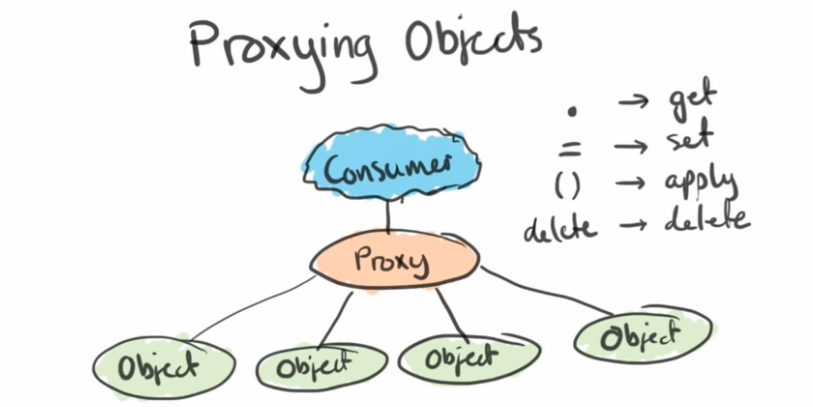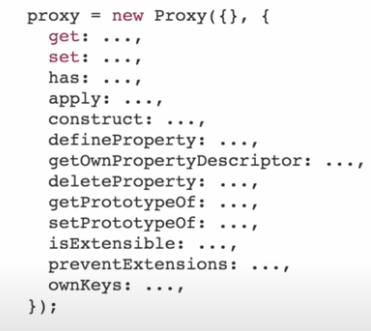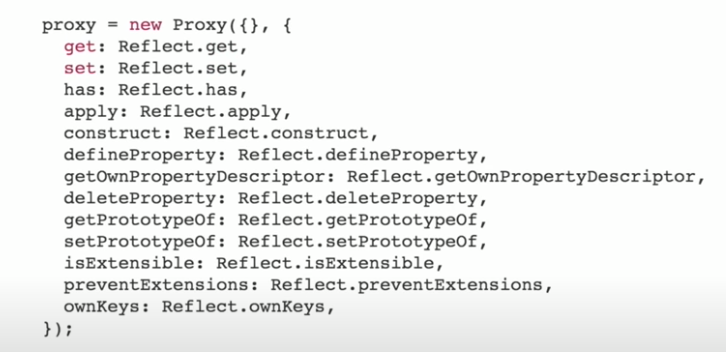Proxy
meta programming.
- operate while the code is running.
- enables powerful intercession.
It is similar to a reverse Proxy in a traditional server-client environment.

We are able to intercept, define, custom behavior for fundamental language operations. (e.g., "property lookup", "assignment", "enumeration", "function invocation", etc.).

Proxies cannot be transpiled or polyfilled.
Syntax
const proxy = new Proxy(target, handler)
- target - can be any object. e.g.,
{},[],function() {}, or even another proxynew Proxy(...). - handler - used to define traps aka., the custom behavior of the proxy.
proxy is transparent. No additional type is added to the target. If you use typeof operator on the proxy object, it will still return the original data type. No such a type called Proxy.
const proxy = new Proxy(() => {}, {});
console.log(typeof proxy); // this will log function
console.log(proxy instanceof Proxy);
// Error: Function has non-object prototype 'undefined' in instanceof check
Handler Function / Trap
Handler functions are sometimes called traps, because they trap calls to the underlying target object. They are functions that define the behavior for the corresponding object internal method.


It's important to realize that all interactions with an object eventually boils down to the invocation of one of these internal methods, and that they are all customizable through proxies.
get()
To customize the proxy, we can define functions on the handler object.
In this example, we provide an implementation of the get(target, property, receiver) handler, which intercepts calls to access properties in the target.
const obj = {
name: "xiaohai",
language: "javascript",
};
const proxy = new Proxy(obj, {
get(target, property, receiver) {
return "defined by the proxy";
},
});
console.log(proxy.name); // 'defined by the proxy'
console.log(proxy.language); // 'defined by the proxy'
this-recovering Proxy
A proxy is still another object with different identity. It operates between the wrapped object (target) and the outside. As such, the proxy does not have direct access to the original object's private properties for example.
class Secret {
#secret;
constructor(secret) {
this.#secret = secret;
}
get secret() {
return this.#secret.replace(/\d+/, "[REDACTED]");
}
}
const aSecret = new Secret("123456");
console.log(aSecret.secret); // [REDACTED]
// Looks like a no-op forwarding...
const proxy = new Proxy(aSecret, {});
console.log(proxy.secret); // TypeError: Cannot read private member #secret from an object whose class did not declare it
When the get secret() {} is invoked, the this value is the proxy variable instead of the original secret variable, so this.#secret will result in an error. To fix this, point this to the secret:
const proxy = new Proxy(aSecret, {
get(target, prop, receiver) {
proxy === receiver; // true
// By default, it looks like Reflect.get(target, prop, receiver)
// which causes the value of `this` in `get secret()` to be `proxy`
return Reflect.get(target, prop, target);
// return target[prop];
},
});
console.log(proxy.secret);
Redirects methods's this value to the original object:
const proxy = new Proxy(obj, {
get(target, property, receiver) {
// redirect `this` to the original object `target`
const value = Reflect.get(target, property, target);
if (value instanceof Function) {
// redirect `this` to the original object `target`
return (...args) => Reflect.apply(value, target, args);
}
},
});
set()
We can perform validations by overriding the set(target, property, newValue) handler.
const validator = {
set(obj, prop, value) {
if (prop === "age") {
if (!Number.isInteger(value)) {
throw new TypeError("The age is not an integer");
}
if (value > 200) {
throw new RangeError("The age seems invalid");
}
}
// The default behavior to store the value
obj[prop] = value;
// Indicate success
return true;
},
};
const person = new Proxy({}, validator);
person.age = 100;
console.log(person.age); // 100
person.age = "young"; // Throws an exception
person.age = 300; // Throws an exception
Revocable Proxy
The Proxy.revocable() method can create a revocable Proxy object.
This means that the proxy can be revoked via the function revoke and switches the proxy off. After switching off the proxy, any operation on the proxy leads to a TypeError (including operations that are not defined in the handler).
const revocable = Proxy.revocable(
{},
{
get(target, name) {
return `[[${name}]]`;
},
}
);
const proxy = revocable.proxy;
console.log(proxy.foo); // "[[foo]]"
revocable.revoke();
console.log(proxy.foo); // TypeError: Cannot perform 'get' on a proxy that has been revoked
proxy.foo = 1; // TypeError: Cannot perform 'set' on a proxy that has been revoked
console.log(typeof proxy); // "object", typeof doesn't trigger any trap
Reflect API
Most methods in this module map one-to-one onto Proxy traps. Proxy handlers can use these methods to conveniently forward operations. The return type of the Reflect methods is guaranteed to be compatible with the return type of the Proxy traps.

Default Forwarding Behavior for Proxy Traps
When using Proxy to wrap existing objects, it is very common to intercept an operation, do something, and then to "do the default thing".
The Reflect and Proxy APIs were designed to work together, such that for each Proxy trap, there exists a corresponding method on Reflect that "does the default thing". Hence, whenever you find yourself wanting to "do the default thing" inside a Proxy handler, the correct thing to do is to always call the corresponding method in the Reflect:
const obj = {
name: "xiaohai",
age: 29,
};
const proxy = new Proxy(obj, {
get(target, property) {
// do something
console.log("!!getting ", property);
// do the default thing
return Reflect.get(...arguments);
// return Reflect.get(target, property);
// compatible with the return type of the trap.
},
});
console.log(proxy.age);
// !!getting age
// 29
In addition to helping with forwarding default operations from the proxy handler to the target, Reflect also provides a few benefits.
A Better apply() Function
Before Reflect, if we want to call a function with a given this and arguments (in an array format), we would need to use Function.prototype.apply(...).
Function.prototype.apply.call(Math.floor, undefined, [1.75]);
With Reflect this becomes less verbose and easier to understand:
Reflect.apply(Math.floor, undefined, [1.75]);
Why use Function.prototype.apply.call instead of func.apply?
Ans: a function might define its own apply method.
In order to make sure that the built-in apply function is called, we should use Function.prototype.apply.call(f, obj, args)👴 or the newer Reflect.apply(f, obj, args)😎.
More Useful Return Values
Many operations in
Reflectare similar to ES5 operations defined onObject, such asReflect.getOwnPropertyDescriptorandReflect.defineProperty.
👴 Object.defineProperty(obj, name, desc) will either return obj when the property was successfully defined, or throw a TypeError otherwise.
😎 Reflect.defineProperty(obj, name, desc) simply returns a boolean that indicates whether or not the property was successfully defined.
This enables us to get rid of the try-catch block:
try {
Object.defineProperty(obj, name, desc);
// property defined successfully
} catch (e) {
// possible failure
// (and might accidentally catch the wrong exception)
}
if (Reflect.defineProperty(obj, name, desc)) {
// success
} else {
// failure
}